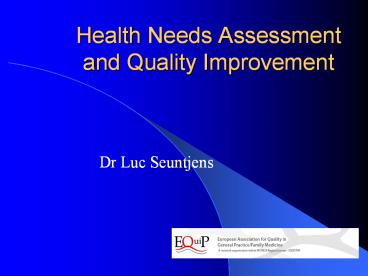Health Needs Assessment and Quality Improvement - PowerPoint PPT Presentation
1 / 28
Title:
Health Needs Assessment and Quality Improvement
Description:
... agency-led. Emphasis: internal (self) assessment. external assessors combined with internal (self) ... Accrediting agency. Primary Stakeholder: Internally-led ... – PowerPoint PPT presentation
Number of Views:99
Avg rating:3.0/5.0
Title: Health Needs Assessment and Quality Improvement
1
Health Needs Assessment and Quality Improvement
- Dr Luc Seuntjens
2
My presentation 3 examples
- Significant event analysis
- European Practice Assessment
- Regional assessment of test-ordering and
intervention using small quality groups
DISCUSSION
DISCUSSION
3
From needs to.quality issues
4
A large bouquet of Quality Improvement approaches
- Implementation of clinical guidelines
- Total Quality Management
- Accreditation and Certification
- Patient Empowerment and Partnership
- Organisational Development methods
- Indicators, accountability and transparancy
- Public reporting and physician profiling
- Business Process Reengineering and Business
Innovation - Breakthrough Collaboratives
- Clinical pathways, case management, managed care
- Balanced Score Cards
- Risk Management , Significant event analysis
- Knowledge management
- Leadership development
- Etc.
5
Quality assessment and quality improvement
(Rhydderch,J Eval Clin Pract. 05)
Externally-led quality assurance/assessment Externally-led quality assurance/assessment Externally-led quality assurance/assessment Internally-led quality improvement
Primary Stakeholder Accrediting agency Government Government Professional body Practice
Purpose commercial accountability regulation accountability regulation self-regulation education service development
Assessment by external assessors (industry based) external assessors external assessors external assessors combined with internal (self) assessment internal (self) assessment
Emphasis accrediting agency-led primary care -led primary care -led GP-led practice-led
Values summative summative summative summative and formative formative
End point certificate certificate licensing contract payment certification local criteria achieved
6
Significant event analysis a little girl with
high fever
7
Fish bone analysis planning improvement
people
infrastructure
Gap of knowledge
No test material
Missed diagnosis of RSV infection
Not aware of RSV epidemic
Friday night
No assistant present
Laboratory does not provide test
practice
external
Planning Improvement
8
Significant event analysis
- Describe the event in a detailed way
- Analyse
- What can be improved?
- Plan actions
9
Round table discussion 1
- How do you deal with significant events in your
practice? - Discuss the strengths and weaknesses of
significant event analysis in your specific
situation.
10
Take home messages
- Needs/Quality problems should be analysed
- Needs are not isolated but refer to different
causes of problems interdependency of needs. - Significant event analysis is a well-accepted and
powerful tool to detect needs and initiate
change.
11
European Practice Assessment (Engels,Grol 2005)
- Researchers from 6 European countries developed
a set of European indicators for management of
primary care - 6 national panels rated the indicators and
achieved a national consensus on a large set of
indicators - A pilot test in 9 countries data collection in
30 practices / country
12
EPA domains
- Infrastructure
- Staff
- Information
- Finance
- Quality and safety
13
EPA the instrument
- Short self-administered questionnaires
- Principle GP or practice manager
- Individual GPs
- Staff members
- Patients
- Observer/facilitator visits the practice
- Structured interview with GP/PM
- Checklist
14
The urgency bag
15
The interview
16
Feedback (VISOTOOL 04)
17
Feedback (Visotool 04)
18
Prioritize and plan improving your practice
19
NA Planning Cycle
Start
20
Quality assessment and quality improvement
(Rhydderch,J Eval Clin Pract. 05)
Externally-led quality assurance/assessment Externally-led quality assurance/assessment Externally-led quality assurance/assessment Internally-led quality improvement
Primary Stakeholder Accrediting agency Government Government Professional body Practice
Purpose commercial accountability regulation accountability regulation self-regulation education service development
Assessment by external assessors (industry based) external assessors external assessors external assessors combined with internal (self) assessment internal (self) assessment
Emphasis accrediting agency-led primary care -led primary care -led GP-led practice-led
Values summative summative summative summative and formative formative
End point certificate certificate licensing contract payment certification local criteria achieved
21
Take home messages
- Needs assessment is a team activity
- Needs assessment is successful in a practice
where improving quality is felt as an internal
responsibility, as part of normal GP work, of
identity, of professionalism - (R.Grol)
22
Quality assessment and quality improvement
(Rhydderch,J Eval Clin Pract. 05)
Externally-led quality assurance/assessment Externally-led quality assurance/assessment Externally-led quality assurance/assessment Internally-led quality improvement
Primary Stakeholder Accrediting agency Government Government Professional body Practice
Purpose commercial accountability regulation accountability regulation self-regulation education service development
Assessment by external assessors (industry based) external assessors external assessors external assessors combined with internal (self) assessment internal (self) assessment
Emphasis accrediting agency-led primary care -led primary care -led GP-led practice-led
Values summative summative summative summative and formative formative
End point certificate certificate licensing contract payment certification local criteria achieved
23
Prescription rate of antihypertensive drugs in
Belgium
24
Regional assessment of test- orderingVerstappen
W, WOK, JAMA May 03
- Involving peer interaction and social
influence improves physician test-ordering
behaviour.
25
Feedback on test ordering Verstappen W, 2004
26
The crucial importance of small group work
Verstappen W, WOK, JAMA, 2003
27
Round table discussion 2
- Government organisations put community priorities
on the "needs" agenda. For example cost-
efficiency related items. - How are these priorities in your country/practice
integrated in your personal or practice CPD
agenda?
28
Take home messages
- Needs of the community/society are to be
integrated in local improvement projects - Quality groups can learn to analyse aggregated
data and prioritize action plans - The power of peers needs assessment in touch
with local attitudes































